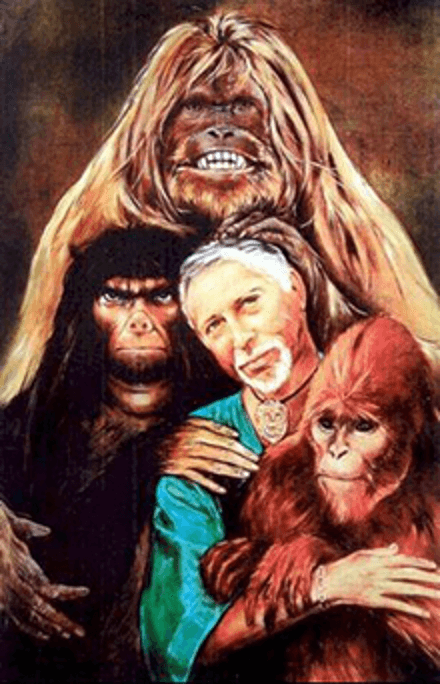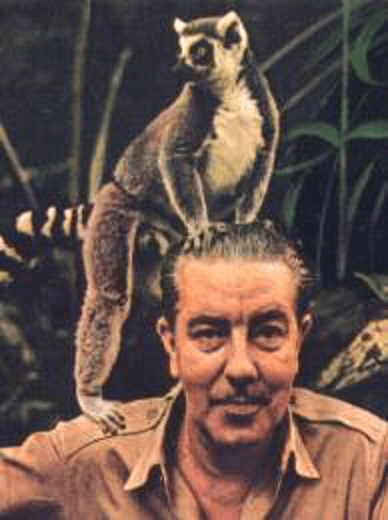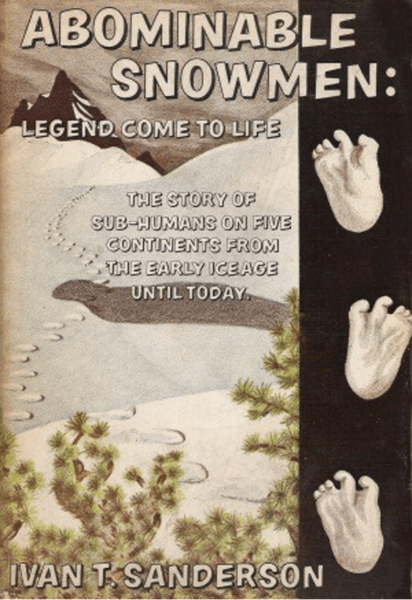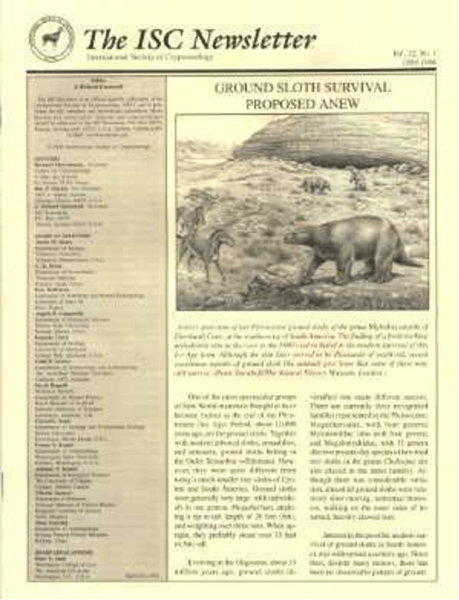The Meaning of Cryptozoology
Who Invented the Term Cryptozoology?
 For years, naturally, I, Loren Coleman, would answer the above question with one person’s name: Bernard Heuvelmans.
For years, naturally, I, Loren Coleman, would answer the above question with one person’s name: Bernard Heuvelmans.
Heuvelmans seemingly promoted the notion that he coined the word, and left it at that. Then, on 24 August 2001, Heuvelmans died, and I wrote an obituary, which found its way as far as the London Times, which propelled notice of his death to the world. Part of what I credited Heuvelmans as accomplishing, as the “Father of Cryptozoology,” was the invention of the word “cryptozoology” itself.
I was partially incorrect.
Cryptozoology, which literally means “the study of hidden animals,” is one of the newest life sciences, and certainly one of the most exciting. During the last half-century of the 20th century, interest in sightings and traditions dealing with “monsters” moved from a shadowy world of travelogues to academic respectability and beyond.
In 1955, zoologist Heuvelmans wrote a groundbreaking book in his native French. This now classic opus is On the Track of Unknown Animals.

The book was soon reprinted in English and several other languages, becoming an international bestseller with over one million books in print through 1995. Supposedly, the first published use of the word “cryptozoology” (in French?) was in 1959 when a book by Lucien Blancou was dedicated to “Bernard Heuvelmans, master of cryptozoology.”
But now, thanks to Mark Rollins, an American environmental manager and artist, it has been brought to my attention that the answer to the question, who invented the word “cryptozoology,” is not so simple. Rollins read my eulogy in December 2001, and emailed me that he remembered from Heuvelmans’ book In the Wake of the Sea Serpents, that someone else actually was responsible for “cryptozoology.” I was stunned.
I read In the Wake of the Sea Serpents when it first came out, and have re-read parts, mostly reference background checks, of it for years. But the specific passage Rollins helped me re-discovery had not come to my attention for years. But I found it quickly.
Speaking of two articles on Sea Serpents that Ivan T. Sanderson wrote in 1947 and 1948 which served as catalysts, Heuvelmans then penned this incredible sentence (first American edition, 1968, p. 508): “When he [Sanderson] was still a student he invented the word ‘cryptozoology’, or the science of hidden animals, which I was to coin later, quite unaware that he had already done so.”
 Intriguingly, Heuvelmans’ 1965 French edition of this same book does not contain this paragraph at all.
Intriguingly, Heuvelmans’ 1965 French edition of this same book does not contain this paragraph at all.
So, who invented the term “cryptozoology”? Apparently, it was Sanderson first, and then Heuvelmans, much later. Cryptozoologists have a little revising to do in our histories about this.
Sanderson, also, is to be credited with being the first to use the word “cryptozoological,” in print in English, in his 1961 book, Abominable Snowmen: Legend Come to Life.
The Evolving Meaning of “Cryptozoology”
ISC’s late Vice President Dr. Roy Mackal has written: “…the term ‘cryptozoology’ seems to me particularly appropriate, coming as it does from the Greek work *kryptos*, meaning ‘hidden.’ ‘unknown,’ ‘secret,’ ‘enigmatic,’ ‘mysterious’; hence literally the study of hidden animals” (Searching for Hidden Animals, Garden City, NY: Doubleday, 1980, p. xi).
 Dr. Karl Shuker has noted that “cryptozoology” is “literally translated as ‘the study of hidden life’” (The Lost Ark, London: HarperCollins, 1993, p. 11), perhaps giving the idea to the reader that this encompasses plants and other non-animal forms.
Dr. Karl Shuker has noted that “cryptozoology” is “literally translated as ‘the study of hidden life’” (The Lost Ark, London: HarperCollins, 1993, p. 11), perhaps giving the idea to the reader that this encompasses plants and other non-animal forms.
This, according to a private 1998 email from Dr. Shuker, is, of course, not what he meant to imply. From my discussions with both the late Richard Greenwell (ISC Sec.) and the late Bernard Heuvelmans (ISC Pres), as well as with various directors on the old ISC Board, the general feeling is that an important element in the study of hidden animals as envisioned in current cryptozoology is the input of local, native, explorer, and traveler traditions, sightings, tales, legends and folklore of the as-yet unverified animals. It is for this very reason that most, but not all, of the animals under pursuit are large ones.
Also, it should be noted, a general sense among Russian cryptozoologists, especially as communicated through the books of Dmitri Bayanov, is that “cryptozoology” is the study of the evidence for hidden animals. Therefore, not too simply, cryptozoology is the study of hidden animals (whether large or small), to date not formally recognized by what is often termed Western science or formal zoology but supported in some way by testimony (in its broadest definition) from a human being and evidence of their presence.
Word game #2: Cryptid
Another word in cryptozoology that sometimes confuses people is “cryptid” and what a cryptid is. We can specifically point to who coined this word, however.
 In the Summer 1983 issue of the Newsletter (vol. 2, no. 2, page 10) of The International Society of Cryptozoology (the ISC is a now defunct organization), John E. Wall of Manitoba introduced the term he had invented for cryptozoological animals through a letter to the editor. By the end of the 1990s, it was showing up in dictionaries.
In the Summer 1983 issue of the Newsletter (vol. 2, no. 2, page 10) of The International Society of Cryptozoology (the ISC is a now defunct organization), John E. Wall of Manitoba introduced the term he had invented for cryptozoological animals through a letter to the editor. By the end of the 1990s, it was showing up in dictionaries.
Cryptid denotes an animal of interest to cryptozoology, of course. Cryptids are in the most limited definition, either unknown species of animals or those that are thought to be extinct but which may have survived into modern times and await rediscovery by scientists.
Writing in 1988 in Cryptozoology the journal of the then active ISC, Heuvelmans underscored the aims of cryptozoology:
“Hidden animals with which cryptozoology is concerned, are by definition very incompletely known. To gain more credence, they have to be documented as carefully and exhaustively as possible by a search through the most diverse fields of knowledge. Cryptozoological research thus requires not only a thorough grasp of most of the zoological sciences, including, of course physical anthropology, but also a certain training in such extraneous branches of knowledge as mythology, linguistics, archaeology and history. It will consequently be conducted more extensively in libraries, newspaper morgues, regional archives, museums, art galleries, laboratories, and zoological parks rather than in the field!”
His definition of cryptozoology itself was exacting, for it gives his sense of what a cryptid is: “The Scientific study of hidden animals, i.e., of still unknown animal forms about which only testimonial and circumstantial evidence is available, or material evidence considered insufficient by some!”
Over the last 10 years some have suggested that the science of cryptozoology should be expanded to include many animals as “cryptids,” specifically including the study of out-of-place animals, feral animals, and even animal ghosts and apparitions. Heuvelmans rejected such notions with typical thoroughness, and not a little wry humor:
“Admittedly, a definition need not conform necessarily to the exact etymology of a word. But it is always preferable when it really does so which I carefully endeavored to achieve when I coined the term `cryptozoology`. All the same being a very tolerant person, even in the strict realm of science, I have never prevented anybody from creating new disciplines of zoology quite distinct from cryptozoology. How could I, in any case?
“So, let people who are interested in founding a science of `unexpected animals`, feel free to do so, and if they have a smattering of Greek and are not repelled by jaw breakers they may call it`aprosbletozoology` or `apronoeozoology` or even`anelistozoology`. Let those who would rather be searching for `bizarre animals` create a `paradoozoology`, and those who prefer to go a hunting for `monstrous animals`, or just plain `monsters`, build up a `teratozoology` or more simply a `pelorology`.
“But for heavens sake, let cryptozoology be what it is, and what I meant it to be when I gave it its name over thirty years ago!”
Unfortunately, many of the creatures of most interest to cryptozoologists do not, in themselves, fall under the blanket heading of cryptozoology. Thus, many who are interested in such phenomena as the so-called Beasts of Bodmin and Exmoor (not unknown species but known species albeit in an alien environment) and the Devonshire/Cornwall “devil dogs” (not “animals” or even “animate” in the accepted sense of the word, and thus only of marginal interest to scientific cryptozoologists) think of these creatures as cryptids.
More broadly, then, we do not know whether a cryptid is an unknown species of animal, or a supposedly extinct animal, or a misidentification, or anything more than myth until evidence is gathered and accepted one way or another. Until that proof is found, the supposed animal carries the label cryptid, regardless of the potential outcome and regardless of various debates concerning its true identity. When it is precisely identified, it is no longer a cryptid, because it is no longer hidden.
While Heuvelmans created cryptozoology as a goal-oriented discipline (endeavoring to prove the existence of hidden animals), the fact that some of these cryptids will turn out not to be new species does not invalidate the process by which that conclusion is reached and does not retroactively discard the prior status as a cryptid. For example, the large unknown “Monster” in a local lake is a cryptid until it is caught and shown to be a known species such as an alligator. It is no longer hidden and no longer carries the label cryptid, but that does not mean it never was a cryptid.
An outsider is bound to be confused by a television program or magazine article that highlights reliable eyewitnesses and physical evidence for hairy bipeds or Lake and Sea Monsters, then jumps to a story about phantom dogs or glowing swamp creature. That confusion is understandable. It is often impossible to tell which category an unknown animal actually inhabits until you catch it. Until then, it is a cryptid.